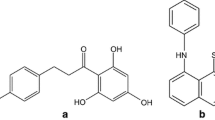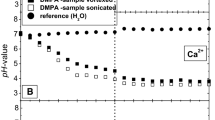Summary
The binding of the hydrophobic fluorescent probe 1-anilino-8-naphthalene-sulfonate (ANS−) on phospholipid vesicle membranes was studied to gain information about the structure and mobility in the polar head group region, and to determine the degree of mixing of lipids on the microscopic scale. The maximal degree of binding of ANS− on dimyristoyl and dipalmitoyl-l-lecithin membranes is one ANS− per four lecithin molecules, indicating a binding site composed of four polar head groups. ANS− bound in this site has a long fluorescent lifetime (5 to 9 nsec) and high quantum yield (0.2 to 0.3), indicating that it is relatively inaccessible to the solvent water. The lack of paramagnetic quenching by added Mn2+ indicates that ANS− bound to those fourmembered sites is also well shielded from added cations. Similarities in the temperature dependence of the binding constant and the reciprocal fluorescent lifetime indicate that the latter is determined by the propensity for polar head group motion and for water and ANS− reorientation during the excited state of the molecule.
Membranes composed of lipids which lack a semi-polar head group (phosphatidic acid) or which have unfavorable polar head group conformations or strong interactions between the polar head groups (dimyristoyl ethanolamine) do not support the binding of ANS− with a high quantum yield and long fluorescent lifetime. Incorporation of these lipids in a lecithin membrane decreases the maximal binding of ANS− to a greater extent than can be explained on the basis of dilution of the lecithin with these lipids. A statistical model is presented, in which incorporation of one or more molecules of the second type into a four-membered lecithin binding site destroys the ability of this site to bind ANS− with a long fluorescence lifetime. Agreement between this model and the results obtained with lipid mixtures indicate that egg phosphatidic acid and dimyristoyl ethanolamine mix well with dimyristoyl lecithin on the microscopic scale. The above criterion was also used to show that cholesterol mixes randomly with lecithin. In contrast to the behavior of the phospholipid mixtures, there was evidence for shortlived ANS− species for cholesterol/lecithin mixtures with mole ratios between 0.6 and 1.0. This species is associated with binding sites in which the lecithin polar head groups are spaced out by the inclusion of cholesterol between the hydrocarbon chains of the lipid molecules. The effects of the ion carrier valinomycin and local anesthetics on the lecithin binding sites are discussed.
Similar content being viewed by others
References
Azzi, A., Chance, B., Radda, G. K., Lee, C. P. 1969. A fluorescence probe of energy dependent structure changes in fragmented membranes.Proc. Nat. Acad. Sci. 62:612
Brand, L., Gohlke, J. R. 1971. Nanosecond time-resolved fluorescence spectra of a protein-dye complex.J. Biol. Chem. 246:2317
Brand, L., Witholt, W. 1967. Fluorescence Measurements.In: Methods in Enzymology. C. H. W. Hirs, editor. Vol. 11, p. 776. Academic Press, Inc., New York-London
Chapman, D. 1972. Nuclear magnetic resonance spectroscopic studies of biological membranes.Ann. N. Y. Acad. Sci. 195:179
Colley, C. M., Metcalf, J. C. 1972. The localization of small molecules in lipid bilayers.FEBS Letters 24:241
Colley, C. M., Metcalfe, S. M., Turner, B., Burgen, A. S. V., Metcalfe, J. C. 1971. The binding of benzyl alcohol to erythrocyte membranes.Biochim. Biophys. Acta 233:720
Conti, F., Tasaki, I., Wanke, E. 1971. Fluorescence signals in ANS-stained squid giant axons during voltage-clamp.Biophysik 8:58
Darke, A., Finer, E. G., Flook, A. G., Phillips, M. G. 1971. Complex and cluster formation in mixed lecithin cholesterol bilayers, cooperativity of motion in lipid systems.FEBS Letters 18:326
Daycock, J. T., Drake, A., Chapman, D. 1971. Nuclear relaxation (T) measurements of lecithin-water systems.Chem. Phys. Lipids 6:205
Durrell, L. 1958. The Alexandria Quartet: Justine. Faber and Faber, London, Ch. I., p. 13
Engleman, D. M. 1970. X-ray diffraction studies of phase transitions in the membrane of mycoplasma laidlawii.J. Mol. Biol. 47:115
Fortes, P. A. G. 1972. Structural properties of the human red cell membrane and anion permeability studied with fluorescence probes. Ph. D. Dissertation, University of Pennsylvania, Philadelphia, Pa.
Haynes, D. H. 1972. Studien der Bindung und des Transportes von Ionen und Molekülen an Phospholipid-Membranen.In: Dechema Monographie, Tutzing Symposion der DECHEMA, Vol. 71, p. 119
Haynes, D. H. 1972. Detection of ionophore cation complexes on phospholipid membranes.Biochim. Biophys. Acta 255:406
Hinz, H.-J., Sturtevant, J. M. 1972. Calorimetric studies of dilute aqueous suspensions of bilayers formed from syntheticl-α-lecithins.J. Biol. Chem. 247:6071
Lecuyer, H., Dervichian, D. G. 1969. Structure of aqueous mixtures of lecithin and cholesterol.J. Mol. Biol. 45:39
Lesslauer, W., Cain, J., Blasie, J. K. 1971. On the location of 1-anilino-8-naphthalenesulfonate in lipid model systems.Biochim. Biophys. Acta 241:547
Levine, Y. K., Bailey, A. I., Wilkins, M. H. F. 1968. Multilayers of phospholipid bimolecular leaflets.Nature 220:577
Lippert, J. L., Peticolas, W. L. 1971. Laser Raman investigation of the effect of cholesterol on conformational changes in dipalmitoyl lecithin multilayers.Proc. Nat. Acad. Sci. 68:1572
Phillips, M. C., Finer, E. G., Hauser, H. 1972. Differences between conformations of lecithin and phosphatidylethanolamine polar groups and their effects on interactions of phospholipid bilayer membranes.Biochim. Biophys. Acta 290:397
Phillips, M. C., Williams, R. M., Chapman, D. 1969. On the nature of hydrocarbon chain motions on lipid liquid crystals.Chem. Phys. Lipids 3:234
Radda, G. K., Vanderkooi, J. 1972. Can fluorescent probes tell us anything about membranes.Biochim. Biophys. Acta 265:509
Schreier-Muccillo, S., Marsh, D., Dugas, H., Schneider, H., Smith, I. C. P. 1973. A spin probe study of the influence of cholesterol on motion and orientation of phospholipids in oriented multibilayers and vesicles.Chem. Phys. Lipids 10:11
Stryer, L. 1965. The interaction of a napthalene dye with apomyglobin and apohemoglobin: A fluorescent probe of nonpolar binding sites.J. Mol. Biol. 13:482
Träuble, H. 1971. Phasenumwandlungen in Lipiden: Mögliche Schaltprozesse in biologischen Membranen.Naturwissenschaften 58:277
Träuble, H., Grell, E. 1971. The formation of asymmetrical spherical lecithin vesicles.Neurosci. Res. Prog. Bull. 9(3):373
Träuble, H., Haynes, D. H. 1971. The volume change in lipid bilayer lamella at the crystalline-lipid crystalline phase transition.Chem. Phys. Lipids 7:324
Träuble, H., Overath, P. 1973. The structure ofEscherichia coli membranes studied by fluorescence measurements of lipid phase transitions.Biochim. Biophys. Acta 307:491
Turner, D. G., Brand, L. 1968. Quantitative estimation of protein binding site polarity. Fluorescence of N-arylnaphthalenesulfonates.Biochemistry 7:3381
Vanderkooi, J., Martonosi, A. 1971. Sarcoplasmic reticulum. XII: The interaction of 8-anilino-1-naphthalene sulfonate with skeletal muscle microsomes.Arch. Biochem. Biophys. 144:87
Weber, G., Laurence, D. J. R. 1954. Fluorescent indicators of absorption in aqueous solution and on the solid phase.Biochem. J. 56:xxxi
Author information
Authors and Affiliations
Rights and permissions
About this article
Cite this article
Haynes, D.H., Staerk, H. 1-Anilino-8-naphthalenesulfonate: A fluorescent probe of membrane surface structure, composition and mobility. J. Membrain Biol. 17, 313–340 (1974). https://doi.org/10.1007/BF01870190
Received:
Revised:
Issue Date:
DOI: https://doi.org/10.1007/BF01870190




